The motor drives the IC to transmit a large amount of current while also dissipating a large amount of electrical energy. Usually, energy is dissipated into the copper plating area of a printed circuit board (PCB). To ensure sufficient cooling of the PCB, it is necessary to rely on special PCB design techniques. In the previous part of this article, we will provide you with some general suggestions for PCB design of motor driven ICs.
Use large area copper plating!
Copper is an excellent thermal conductor. Due to the poor thermal conductivity of the PCB substrate material (FR-4 glass epoxy resin). Therefore, from the perspective of thermal management, the more copper plated areas in a PCB, the more ideal the thermal conductivity.
A thick copper plate with a thickness of 2 ounces (68 microns) has better thermal conductivity compared to a thin copper plate. However, thick copper is not only expensive, but also difficult to achieve precise geometric shapes. So typically, 1 ounce (34 microns thick) copper plate is chosen. The outer board often uses 1/2 ounce copper plating, with a thickness of up to 1 ounce.
The inner layer of multi-layer boards often uses solid copper plates for better heat dissipation. However, due to the fact that its planar layers are usually located at the center of the circuit board stack, heat may be locked inside the circuit board. So, you can add a copper plating area on the outer board of the PCB and connect it to the inner board through holes to transfer heat.
Due to the presence of wiring and components in double-layer PCBs, heat dissipation will also be more difficult. So the motor driven IC should use as many solid copper plates as possible and through holes that are conducive to heat dissipation. Cast copper on both sides of the outer board and connect them together using via holes, which can disperse heat to different areas separated by wiring and components.
The wiring must be wide - the wider the better!
Because the current flowing through the motor drive IC is very high (sometimes exceeding 10A), careful consideration should be given to the PCB wiring width when connecting to the chip. The wider the wiring, the smaller the resistance. The width of the wiring must be adjusted to ensure that the resistance in the wiring does not dissipate too much energy and cause an increase in wiring temperature. But if the wire is too thin, it is like an electric fuse and can easily be burned off.
Designers usually use the IPC-2221 standard to calculate the appropriate wiring thickness. This specification has a chart that displays the cross-sectional area of copper at different current levels and its allowable temperature rise, which can be converted to the wire width based on the given copper layer thickness. For example, in a copper layer with a thickness of 1 ounce, a 10A current load requires a wiring width of exactly 7mm to achieve a temperature rise of 10 ° C. Therefore, for a current of 1A, only 0.3mm of wiring is needed.
If calculated based on this method, it seems impossible to operate a 10A current through a micro IC pad.
So, it is important to understand the recommended wiring width for long PCBs with constant width in the IPC-2221 standard. If the wiring is connected to a larger wiring or copper area, using a small section of PCB wiring to transmit a larger current will not have any adverse effects. This is because the short and narrow PCB wiring resistance is very small, and the heat generated is sucked into a wider copper laying area. From the example in Figure 1, it can be seen that even if the heat dissipation pad in this device is only 0.4mm wide, it can still carry a continuous current of up to 3A, because the wiring is widened to be as close as possible to the actual width of the device.

Figure 1: Widening PCB wiring
Due to the fact that the heat generated by narrower wiring is conducted to a wider copper laying area, the temperature rise of narrow wiring can be ignored.
The heat dissipation effect of the wiring embedded in the inner layer of the PCB is not as good as that of the outer layer wiring, because the thermal conductivity of the insulator is poor. Because of this, the width of the inner wiring should be twice that of the outer wiring.
Table 1 roughly provides the recommended widths for long runs (greater than 2cm) in motor drive applications.
|
electric current (RMS or DC) |
The wiring width is 1 ounce with copper laying |
The wiring width is 2 ounces with copper laying |
||
|
Outer panel |
Inner Layer Board |
Outer panel |
Inner Layer Board |
|
|
≤1A |
0.6mm |
1.2mm |
0.3mm |
0.6mm |
|
2.5A |
1mm |
2mm |
0.5mm |
1mm |
|
5A |
2.5mm |
5mm |
1.2mm |
2.5mm |
|
10A |
7mm |
14mm |
3.5mm |
7mm |
Table 1: PCB wiring width
If space permits, wider wiring or copper filling can minimize temperature rise and voltage drop.
Hot via - more is better!
A through hole is a small plated hole commonly used to transmit signal routing from one layer to another. As the name suggests, a thermal via is the process of transferring heat from one layer to another. Proper use of hot via holes can effectively help PCB heat dissipation, but it is also necessary to consider many issues in actual production.
The through-hole has thermal resistance, which means that whenever heat flows through it, there will be a certain temperature difference between the two ends of the through-hole, measured in degrees Celsius per watt. Therefore, in order to minimize thermal resistance and improve the heat dissipation efficiency of the through-hole, the through-hole should be designed larger, and the larger the copper coverage area inside the hole, the better (see Figure 2).
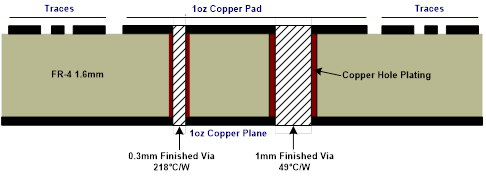
Figure 2: Cross section of through-hole
Although large via holes can be used in the open area of a PCB, they are often placed inside the heat dissipation pad, as this allows for direct heat dissipation from the IC package. In this case, it is not possible to use a large through-hole, as excessive electroplating holes can lead to "tin infiltration", where the solder used to connect the IC to the PCB will flow downwards into the through-hole, resulting in poor solder joints.
There are several methods to reduce tin infiltration. One method is to use very small through holes to reduce the amount of solder that seeps into the holes. However, the smaller the via, the higher the thermal resistance, so in order to achieve the same heat dissipation performance, more small via are needed.
Another technique is to "cover" the via on the back of the circuit board. This requires removing the opening of the solder mask layer on the backboard, so that the solder mask material covers the through-hole. The solder mask layer will cover small through holes, preventing solder from penetrating the PCB.
But this will bring another problem: flux retention. If a solder mask is used to cover the through-hole, the flux will remain inside the through-hole. Some flux formulations are corrosive and if left untreated for a long time, it can affect the reliability of the chip. Fortunately, most modern non cleaning flux processes are non corrosive and will not cause any problems.
It should be noted that the heat dissipation holes themselves do not have heat dissipation function and must be directly connected to the copper laying area (see Figure 3).
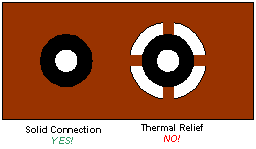
Figure 3: Hot via
It is recommended that PCB designers negotiate with SMT process engineers at PCB assembly plants to determine the optimal through-hole size and structure, especially when the through-hole is located inside the heat dissipation pad.
Welding heat dissipation pads
In TSSOP and QFN packaging, there are large heat dissipation pads soldered to the bottom of the chip. The solder pads here are directly connected to the back of the chip to provide heat dissipation for the device. The pads must be soldered well onto the PCB to dissipate power.
The IC specification may not necessarily specify the opening of the solder paste on the solder pads. Usually, SMT process engineers have their own set of rules for how much solder to put and what shape to use for through-hole molds.
If an opening of the same size as a solder pad is used, more solder is required. When the solder melts, its tension causes the surface of the device to bulge. In addition, it can also cause solder voids (internal cavities or gaps in the solder). When the volatile substances of the flux evaporate or boil during the reflow process of solder, solder voids will occur. This will cause the solder to precipitate at the joint.
To address these issues, for pads with an area greater than approximately 2mm2, solder paste is typically deposited in several small square or circular areas (see Figure 4). Distributing the solder in multiple smaller areas can make it easier for the volatile substances of the flux to evaporate, avoiding solder precipitation.

Figure 4: QFN welding tool
I suggest that PCB designers and SMT process engineers work together to negotiate the correct opening for the heat dissipation pad mold. You can also refer to some online papers.
Component mounting
The component installation guide for motor drive ICs is the same as other power ICs. The bypass capacitor should be placed as close as possible to the power pin of the device, and a large capacity capacitor should be placed next to it. Many motor driven ICs use bootstrap capacitors or charging pump capacitors, which should also be placed near the IC.
Please refer to the component mounting example in Figure 5. Figure 5 shows the layout of the double-layer PCB driven by the MP6600 stepper motor. Most signal wiring is directly arranged on the top floor. The power supply is routed from a high-capacity capacitor to a bypass, and multiple vias are used at the bottom layer and at the location of layer replacement.
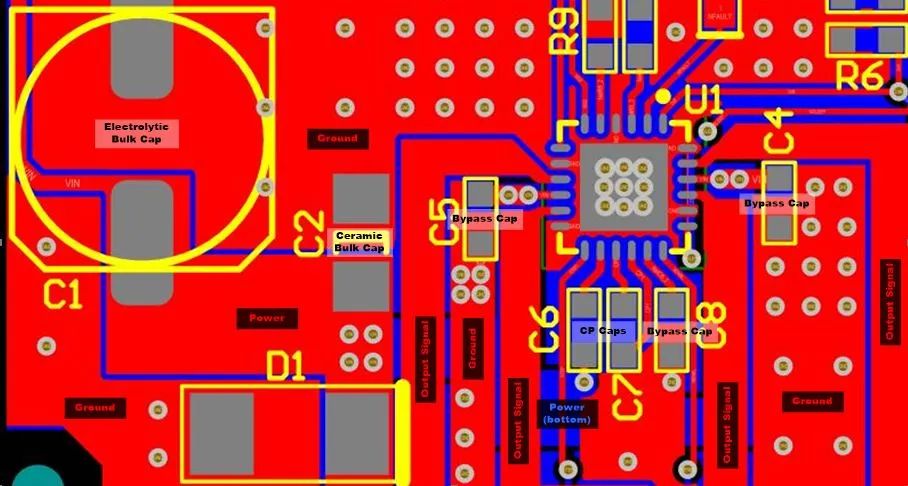
Figure 5: MP6600 component mounting
In the second part of this article, we will explore detailed packaging methods and PCB layout for motor drive ICs.
Part Two
In the previous article of this article, some general suggestions were provided for using motor driver ICs to design PCB boards, requiring careful layout of PCBs to achieve appropriate performance. In the second part of this article, specific PCB layout suggestions will be provided for motor drivers using typical packaging.
Lead packaging layout
Standard lead packaging (such as SOIC and SOT-23 packaging) is commonly used in low-power motor drivers (Figure 6).
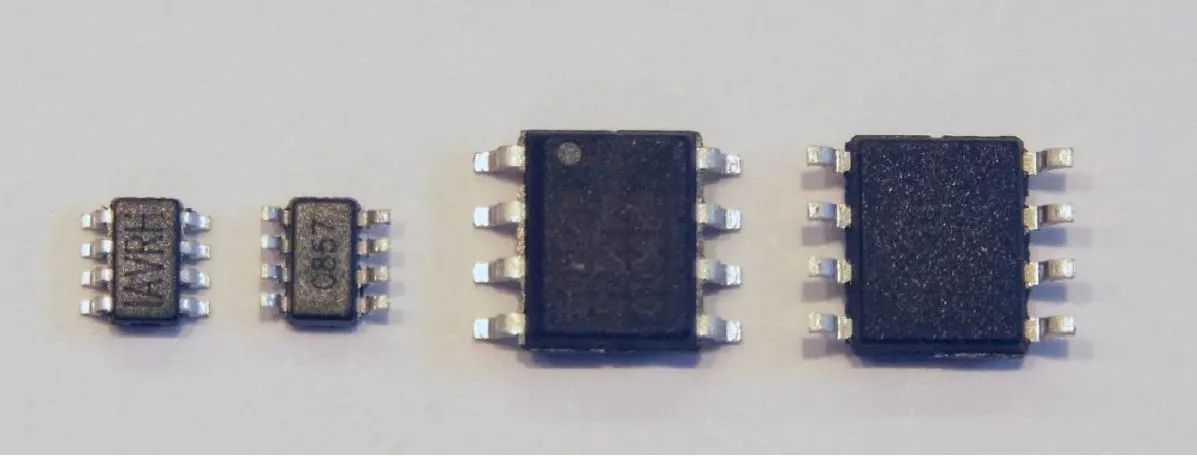
Figure 6: SOT 23 and SOIC packaging
In order to fully improve the power consumption capability of lead packaging, MPS company adopts the "flip chip lead frame" structure (Figure 7). Without using bonding wires, copper bumps and solder are used to bond the chip to metal leads, allowing heat to be transferred from the chip to the PCB through the leads.

Figure 7: Flipped chip lead frame
By connecting larger copper areas to leads carrying larger currents, thermal performance can be optimized. On the motor driver IC, the power, ground, and output pins are usually connected to the copper area.

Figure 8: Inverted chip SOIC PCB layout
Figure 8 shows a typical PCB layout of the "flip chip lead frame" SOIC package. Pin 2 is the device power pin. Please note that the copper area is located near the top layer of the device, and several through holes connect the area to the copper layer on the back of the PCB. Pin 4 is the grounding pin and is connected to the copper plated grounding area on the surface. Pin 3 (device output) is also routed to a larger copper area.
QFN and TSSOP packaging
The TSSOP package is rectangular and uses two rows of pins. The TSSOP packaging of motor driver ICs usually has a large exposed board at the bottom of the packaging to remove heat from the device (Figure 9).

Figure 9: TSSOP Packaging
The QFN package is a lead-free package with a board around the outer edge of the device, and a larger board in the center at the bottom of the device (Figure 10). This larger board is used to absorb heat from the chip

Figure 10: QFN Packaging
To eliminate heat from these packages, the exposed panels must be well soldered. The exposed board is usually at a ground potential, so it can be connected to the PCB ground plane. In the example of TSSOP packaging in Figure 11, an 18 through hole array with a drilling diameter of 0.38 mm is used. The calculated thermal resistance of this through-hole array is approximately 7.7 ° C/W.

Figure 11: TSSOP PCB layout
Usually, these hot through holes use a drilling diameter of 0.4 mm or smaller to prevent tin infiltration. If the SMT process requires the use of smaller pore sizes, the number of pores should be increased to maintain a lower overall thermal resistance as much as possible.
In addition to the through holes located in the board area, there are also hot through holes in the external area of the IC body. In TSSOP packaging, the copper area can extend beyond the end of the package, providing another way for heat in the device to pass through the top copper layer.
Avoid using copper layers at the top to absorb heat on the boards around the edges of QFN device packaging. Hot through holes must be used to dissipate heat to the inner layer or bottom layer of the PCB.
The PCB layout in Figure 12 shows a small QFN (4 × 4 mm) device. In the exposed panel area, only nine hot through-holes are accommodated. Therefore, the thermal performance of the PCB is not as good as the TSSOP packaging shown in Figure 11.

Figure 12: QFN (4mmx4mm) Layout
Inverted chip QFN packaging
Flipped chip QFN (FCQFN) packaging is similar to conventional QFN packaging, but its chips are directly connected to the bottom board of the device in an inverted manner, rather than using bonding wires to connect to the packaging board. These boards can be placed on the opposite side of the heating power device on the chip, so they are usually arranged in a long strip shape instead of a small board shape (see Figure 13).

Figure 13: FCQFN Packaging
These packages use multiple rows of copper protrusions bonded to the lead frame on the surface of the chip (Figure 14).
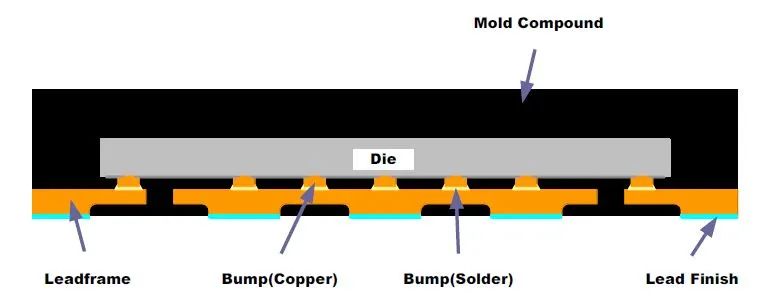
Figure 14: FCQFN Structure
Small through-holes can be placed within the board area, similar to conventional QFN packaging. On multi-layer boards with power and grounding layers, through holes can directly connect these boards to each layer. In other cases, the copper area must be directly connected to the board in order to draw heat from the IC into the larger copper area.
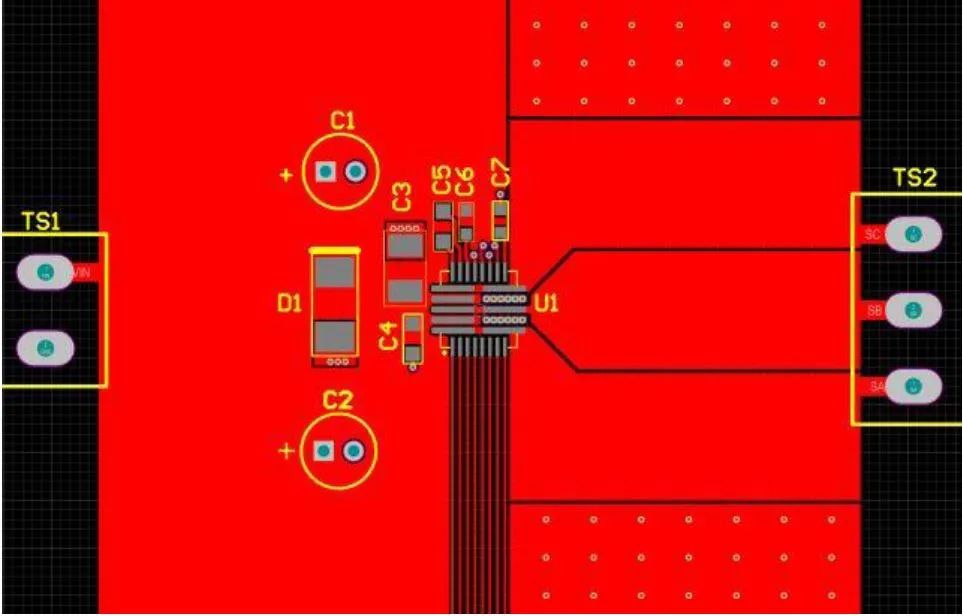
Figure 15: FCQFN PCB layout
Figure 15 shows the power level IC MP6540 of MPS company. This device has a longer power and ground plate, as well as three output ports. Please note that the package is only 5mm x 5mm.
The copper area on the left side of the device is the power input port. This larger copper area is directly connected to the two power boards of the device.
Three output boards are connected to the copper area on the right side of the device. Pay attention to expanding the copper area as much as possible after exiting the board. This can fully transfer heat from the board to the ambient air.
Meanwhile, pay attention to the rows of small through holes in the two boards on the right side of the device. These boards are all grounded, and a solid grounding layer is placed on the back of the PCB. These through-holes have a diameter of 0.46 mm and a drilling diameter of 0.25 mm. The through-hole is small enough to fit within the board area.
In summary, in order to implement successful PCB design using motor driver ICs, careful layout of the PCB is necessary. Therefore, this article provides some practical suggestions to help PCB designers achieve good electrical and thermal performance of PCB boards.
